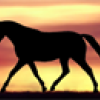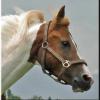Rabicano Question and mane color question
Forums
Re: Rabicano Question and mane color question
It is thought by researchers that rabicano is a dominant trait. Our analysis of families segregating for rabicano would seem to bear that out, although they are rare enough that it's hard to be sure. If it is a simple dominant, it sounds like your mare is heterozygous for rabicano and will therefore throw rabicano foals 50% of the time.
Not all rabicanos exhibit the traditional coloring of "flank-only" roaning. This may be because there are modifying genes at work, or because some horses have other genes, like true roan or sabino, that cause additional roaning on the foals.
Re: Rabicano Question and mane color question
I'll get in touch with the owners of the solid black colt... he was sold at 8 months, and is now a yearling. Since some of his older siblings did show their rabicano traits later (as yearlings), it is possible he did inherit the gene, and just hadn't expressed it yet. I didn't fully clip him before he sold (only head and necked him), so it is possible I just missed any roaning (he was a HAIRY colt).
This mare did have two other foals for her previous owner before me. The gelding is very roaned now (sired by a solid buckskin), and the filly was sired by a pintaloosa stallion, and is also roaned, with high socks on all four. I have never seen either of these foals in person, only in pictures. This is what they were described as, and appeared to be in the pictures.
All of these horses (except the pintaloosa sired filly) appear to be solid, save for the rabicano roaning. I didn't think there were other modifying genes, but it is possible. Thank you for your help.
Re: Rabicano Question and mane color question
No appy charakteristiks - no striped hooves, no mottled skin
only a white streak along the withers (about 10cm), the white hair at the tail and slight flank roaning which grows more as you reach the tummy.
[img]http://whynot-ponys.de/images_big/v-la%…] [img]http://whynot-ponys.de/images_big/v-la%…]






Re: Rabicano Question and mane color question
Hi and welcome to the board !
There is not currently a test for Rabicano and we just tend to look for it's various traits in horses instead, sounds like you have one anyways but what you have described and having various different colours in the manes and tails of chestnuts is quite common. Your mare could keep producing foals with a bit of chrome every time she is bred...just depends on the odds.